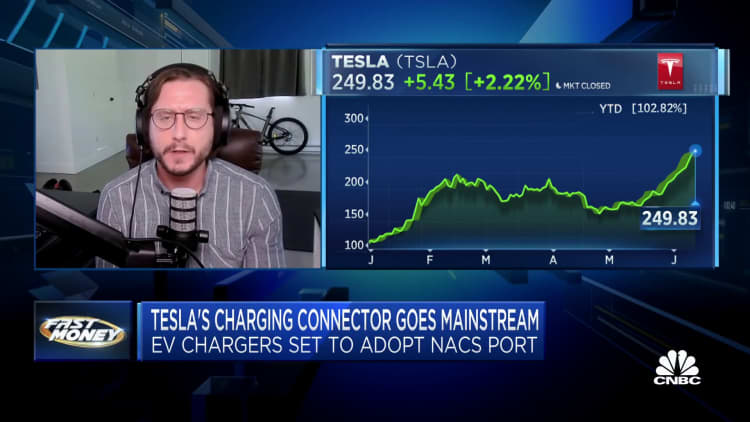A Tesla electric car plugged into a charging terminal at a Healthy Living Market store in South Burlington, Vermont, June 18, 2023.
Robert Nickelsberg | Getty Images
As of Thursday, owners of Ford Electric vehicles – Mustang Mach-E and F-150 Lightning – in North America finally have the ability to power themselves using Tesla Superchargers.
Ford CEO Jim Farley wrote in a LinkedIn post that the charging partnership, which involves the use of fast-charging adapters, should “enhance the electric vehicle ownership experience” for drivers. Ford electric vehicles, noting that “I’ve tested it personally and it works Great.”
Tesla has made a similar deal with General Motors, announced in June, giving GM customers access to more than 12,000 Tesla fast chargers in the U.S. and Canada. GM CEO Mary Barra said at the time that her company expected to save up to $400 million on its planned investment in building electric vehicle charging stations.
The partnerships mark a shift in strategy for Tesla CEO Elon Musk, who for years touted the exclusivity of Tesla’s charging network and his company’s ability to build reliable charging points that would keep consumers from standing in long lines. Becoming the charging standard required Tesla to invest heavily in technical and commercial development.
But Tesla has a lot to gain from collaborating with others.
Sam Fiorani, vice president of global forecasting at AutoForecast Solutions, said these efforts should ultimately yield huge financial benefits for Tesla, including environmental credits and fees for charging sessions.
Currently, Tesla operates approximately one in three charging stations in the United States. Even if adoption of battery electric vehicles slows nationwide and the EV fleet is smaller than the government and many automakers predicted six months ago, “Tesla could still make $6 billion” to $12 billion dollars per year,” by 2030 from expanding its charging business, Fiorani said in an email.
While Tesla may lose some customers to other brands by making charging easier, AutoForecast says there are other reasons why car buyers are turning to Tesla.
“People who buy a Tesla don’t generally cross-shop at Kia, Ford or Mercedes-Benz dealerships because they simply want a Tesla,” Fiorani wrote. “Competition will continue to heat up and Tesla will inevitably lose some sales to rivals, but brand loyalty means the vast majority of owners will return to Tesla with little or no comparison shopping.”
Allowing other automakers to take advantage of its charging network also opens up some federal money for Tesla under President Biden’s Inflation Reduction Act.
“Tesla is not afraid to use government regulations to obtain revenue and has exploited all possible revenue streams for much of its existence,” Fiorani wrote.
Tesla did not respond to a request for further information.
Tesla reports charging revenue with its “Total Automotive and Service Revenue and Other Segments.” The company hasn’t said whether it might earn revenue from the use of non-Tesla vehicles on its charging network.
William Navarro Jameson, Tesla’s head of strategic charging programs, wrote in a LinkedIn post Thursday that getting to this point with Ford required a lot of “interoperability testing” along with building all the necessary hardware and software integrations and resolving of legal issues.
“There have been so many pieces of this puzzle that have been put into place over the last 18 months,” he wrote.
On social media, Tesla touted the opening of its charging network in North America and released a link to entice more retailers to host Superchargers at their facilities.
CLOCK: The Tesla charging connector is set to become the standard for electric vehicles in North America
